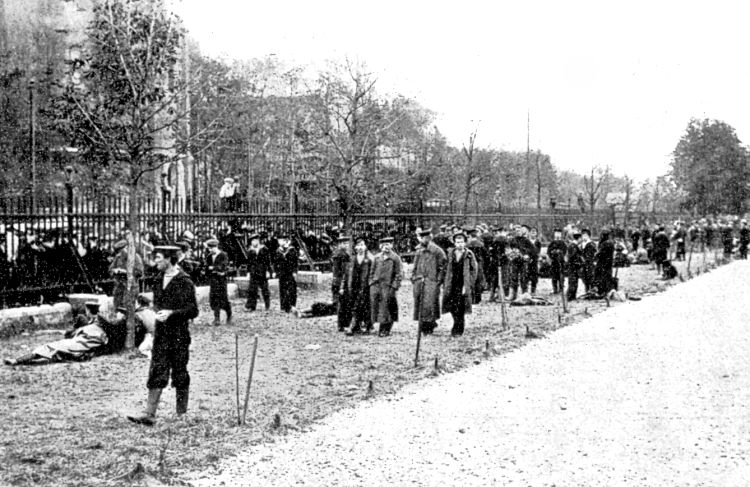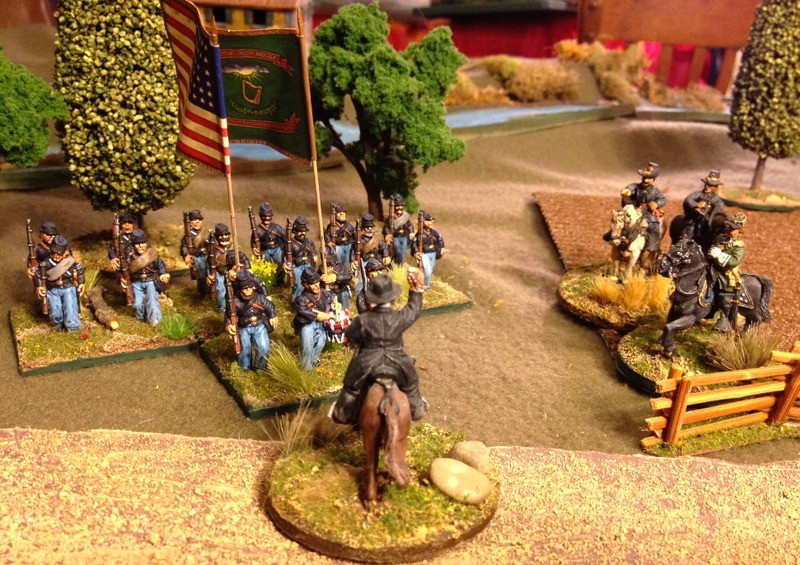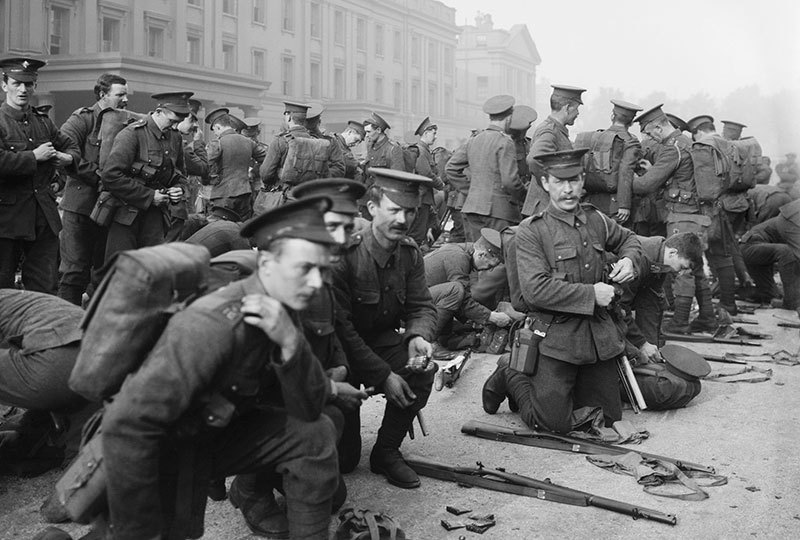It’s Tuesday and as part of my highly irregular Tuesday Boardgame feature, I actually have something to say about playing GMT’s A Distant Plain, Brian Train and Volkho Ruhnke’s simulation of contemporary warfare in Afghanistan as part of GMT’s COIN (CounterInsurgency) series. It seems apropos to talk about this game tonight, seeing as the newly elected (and bodged together) Afghan government has just signed a deal with the US to continue to allow American troops to remain in country, this signalling that the war isn’t quite over, or at least, has moved to a new phase. However, as one of the longest running wars of modern (and post-modern time) I think Afghanistan deserves a simulation, and got a good one in this title.
I did say a little about ADP in a previous blog post, and if you want to get a much smarter analysis than I could provide, I recommend Brant from Groghead’s review here or Professor Rex Brynen’s equally insightful review on Paxsims here. What I offer here is a play by play account of my own attempt to play the game solo. If you are not into looking at blocks on a board, and some of my previous posts suggest few of you are, than move on, nothing to see here, TLDR, etc. However, if you’re curious to see how the game feels and plays,and how the rules work (or how I’ve misunderstood them), this may be of interest to you.
I wish I had taken a picture of the board setup before I started. I chose the 2003-2013 scenario, which starts after the US-led coalition has moved on from Afghanistan to Iraq and discovered that all is not quiet in Afghanistan after all. You can check the dispositions on the last page of the game rules, which are on the GMT website here. A quick note on how this works. I’m playing the game solitaire, and I can choose any of the four factions, the Coalition (US/NATO/allies), the Government (basically the Karzai govt), the Taliban, or the Warlords (a composite of the northern, non-Pashtun tribes and leaders who are looking after their own interests). Perhaps it’s a lack of imagination, but I chose the Coalition. The other three factions are governed by a series of non-player matrixes, basically decision trees which give certain actions depending on the conditions on the board at the time.
The game is card driven. The sequence of play is randomized on each card. If you look at the first photo below, the top of the card has four logos. They are: Govt (blue), Coalition (Brown w white star), Taliban (black w crescent and star) and Taliban (green w a thingy). The sequence changes with each card. Basically, only two factions get to act per card. If this was a four player game it would be awesome because the next card is revealed while the current card is being played, giving all four players a myriad of choices: do I take my turn now, do I pass and act later to counter the devastating action another player is about to get to do, do I want to take advantage of an Event or wait, etc etc. It would be like poker with a few of the cards revealed in each player’s hand. Solitaire is not quite so exciting but the NP matrixes are good company.
So here goes. In the pictures below, I use red and white tokens to help show which provinces are in play at the moment the picture is taken.
First card: #37, Afghan Commandos. This card gives the Government a free Sweep action and a free Assault action, which only Troops can perform. For each 2 Troops (rounded down), one Taliban Guerrilla is activated (basically revealed), which means that it can then be assaulted and eliminated (underground or non-revealed Guerrillas, both Warlord and Talib, are immune from attack). Using the Non-Player matrix to determine the Govt’s actions, this is an event card that the Govt will use so the Event happens.
The Government starts the game with three Troops (the dark blue blocks): two in Kabul and one in Herat, so thanks to this card they can all move to one space. There are currently only two provinces under Talib control, Paktika and Zabol, so the Govt sends three troops to Paktika. .

That’s enough to do the job . The Talib Guerrilla and Base are both eliminated and Paktika flips from Talib to COIN control.

The Coalition is the next player up and since the first (Govtt) chose the Event, the second player can do an Operation and a Special Activity. The Coalition player needs more troops on the board, and so elects a Train operation. This can only be done where there is a COIN base, and so far the only COIN base is in Kabul. The Coalition trains three Police and three Govt Troops in Kabul, and pays three Govt resources to do so (the Coalition does not have it’s own resource track, but rather uses Govt resources), moving Govt resources from 20 to 17, and then does a civic action to Increase Kabul from Neutral to Support (each space or province has three possible levels of political activity, Opposition, Neutral and Support). In the photo below, Kabul now has five ANP (police, light blue blocks), three ANA (troops, dark blue), three Coalition troops (tan), and markers showing COIN control and Support. I’m now feeling pretty good about Kabul as my base camp going forward.

For the Coalition’s Special Activity, it elects a Surge, since it seems that this is the only way it can bring Coalition Bases and Troops onto the board. The Coalition can chose to do this in three areas where there is COIN control per turn, so it choses to bring a base and two troops each to Khowst and Paktika provinces,

And a base and two troops to Kandahar province.

Since two factions have gone on the first card, we go to the the next card which is #70, Contractor Surge.

This card represents large amounts of aid flowing around the country and benefiting everyone. The card allows up to three provinces with COIN (Govt + Coalition) pieces to be shifted 1 level towards Support (there are three levels, Opposition, Neutral and Support) so Kandahar, Herat and Paktika are all moved from Neutral to Support. For three provinces each with 1 level shift, that gives the Warlord and Talib factions three resources points each to represent graft and sloshing around of aid contracts. Now the Warlord faction can a
According to the Warlord Non-Player matrix, since there are more than 6 pieces available, Warlord will choose a Rally operation in three spaces. Warlords choose provinces with high populations, putting one Guerrilla each in Nuristan, Baghlan and Kabul. The Warlord player can also choose a Special Activity, and the Non-Player Matrix says Cultivate so since it now has a guerrilla in Nuristan and there are no Govt police there, the Warlord puts a Base in Nuristan.

Note: In looking at the non-player matrix, I realize that I misunderstood the card. I thought Contractor Surge automatically happened but it is an Event that a Faction can choose to happen, and I goofed. The NP Matrix says the Warloods would have chosen an Op and a Special Activity INSTEAD of the Event, and I applied the Event and gave the Warlords an OP +SA. It’s now past my bedtime, so I’ll let that stand and pick this up later with the Taliban being next on the card.
The Taliban are the only other faction eligible to move on this card. Since W went first with an OP+SA, if all factions were player controlled, the second faction would only get a Limited Op, but in reading rule 8.1, NP factions do not do LimOps. They get a full Operation plus Special Activity. Happy days for the Taliban.
According to the matrix, since Talib do have 15+ pieces, they rally. A Talb piece must be placed in Kabul,, then a piece to gain control in a province so a piece is placed in Ghazni which is wide open, then pieces are placed where there are 1-2 Talib pieces, so one is placed each in Zabol, Waziristan (Pakistan) and NW Frontier (Pakistan). Then the matrix says that the Talib then buy Sharia (basically a political action) in one place where they can achieve the greatest shift, so Zabol province is moved from Neutral to Oppose status.
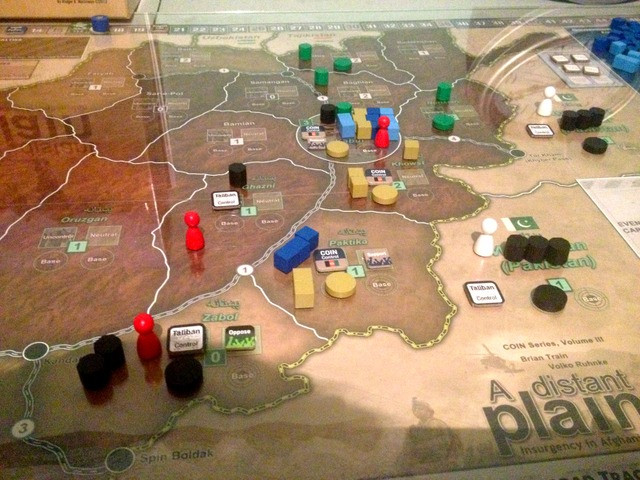
The Talib have done Rally in five provinces and Sharia for one, so the cost for this turn is 6 resources. For their Special Activity, the Matrix says the Talib will choose Extort, which is good because they are now down to 2 Resources. There are four provinces (Zabol, Ghazni, Waziristan, NW Frontier) where Talib dominate, so they can Extort there, gaining one resource per province for a total of four, taking the total Talib resources to 6. That ends the Taliban turn. Because Warlords and Talib both acted on this card, their markers go to the Ineligible Factions box the next card.
The next card is #61 Desertions and Defections.

The first two factions at the top of the card are Warlords then Talib, but both are Ineligible this turn so the turn goes to the third faction shown, Coalition. The Coalition cannot play the Event on this Card, so it has to decide on a COIN operation. Hmm, as a Player Faction and without a Matrix to guide me, (this is tricky, I have to make my own decision!) but the Train op seems a smart way at this early stage to get COIN pieces on the board. I choose Kandahar province since it has a COIN (Coalition) base there, and spend 3 Govt resources to add 6 Govt pieces (3 ANA and 3 ANP) to Kandahar province. Train allows me to do a Civic Action but Kandahar is at Support so I don’t need to do that. I could cash three Govt pieces in for a Govt base, but there only three Govt bases available total, and I have a feeling I should save them for now.

So that’s it for the Train op. The Coalition has a Special Activity and of the three (Surge, Airlift, Airstrike) I chose Airlift, which allows me to move up to three Govt troops to any three spaces in Afghanistan. I choose to drop two of my newly trained Govt troops into Ghazni (where, since I outnumber the sole Talib piece 2-1, I get COIN control of Ghazni) and one to Oruzgan (where I also get COIN control since the Govt troops is the only piece in the province).

This ends the Coalition turn for this card.
Now I need to consult the Matrix for the Govt faction. The Matrix says that the Govt ignores the Desertions and Defections Event on the card and does an Op and SA instead. Since the Govt has more than 15+ pieces unplaced and has several provinces where it can Govern with effect, the matrix says the Govt will Train as its op. The matrix says the Govt can only Train (place cubes) where there is a COIN base and only where there are at most 6 COIN cubes in excess of the number needed to gain control (control = more COIN or Talib pieces than all enemies combined in a space) of a province. The only province that meets that criteria is Paktika, so it gets 3 ANA and 3 ANP cubes.The Govt can also do a Civic Action in one space where there are no COIN bases, and since Orusgan is the only province in COIN control with no base and room to move increase Support. Since Oruzgan has no COIN base, it moves from Neutral to Support.

The total Govt cost for these two actions (Training and placing cubes in Paktika, Civic Action in Orzugan) is 6 (3 each) and so the Govt resources drops from 12 to 6. For its Special Activity, the matrix says the Govt can Govern in up to two areas where there is COIN control, Support or 0 population. Whether the Governing is Benign (which adds population to the province as refugees and displaced persons return) or not (if there is no Coaliton base, the Govt can extract patronage, which ticks people off) depends on a die roll in excess of the 6 available +1 population counters (which represent the limit of possible population boosts in the game), and since none are in play yet, the Governing will not be begin. In Oruzgan and Herat, there is no Coalition base, there is Support and COIN control, so the Govt can Govern in those provinces, taking the population value of the two provinces (1 each) and diverting that amount (a total of 2) from Aid to patronage.
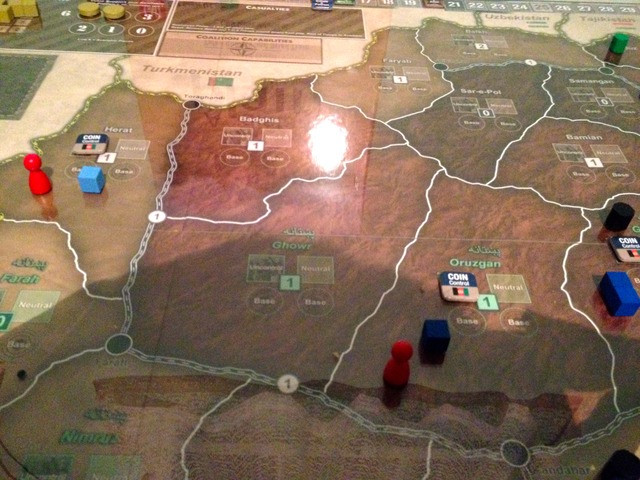
Both provinces go from Support to Neutral. That all sounds very rascally. AID drops 2 to 13, Patronage increases 2 to 17.
That ends the Govt turn. For the next card, the Govt and Coalition are now ineligible factions, and Talib and W are eligible. I confess at this point I am still not sure where this is all going but hopefully those of you who are curious will learn more next Tuesday, God willing. So far it looks as if the Govt and the Coalition are doing well, judging from the number of pieces on the board, but I suspect that could change easily.
Cheers,
MP












